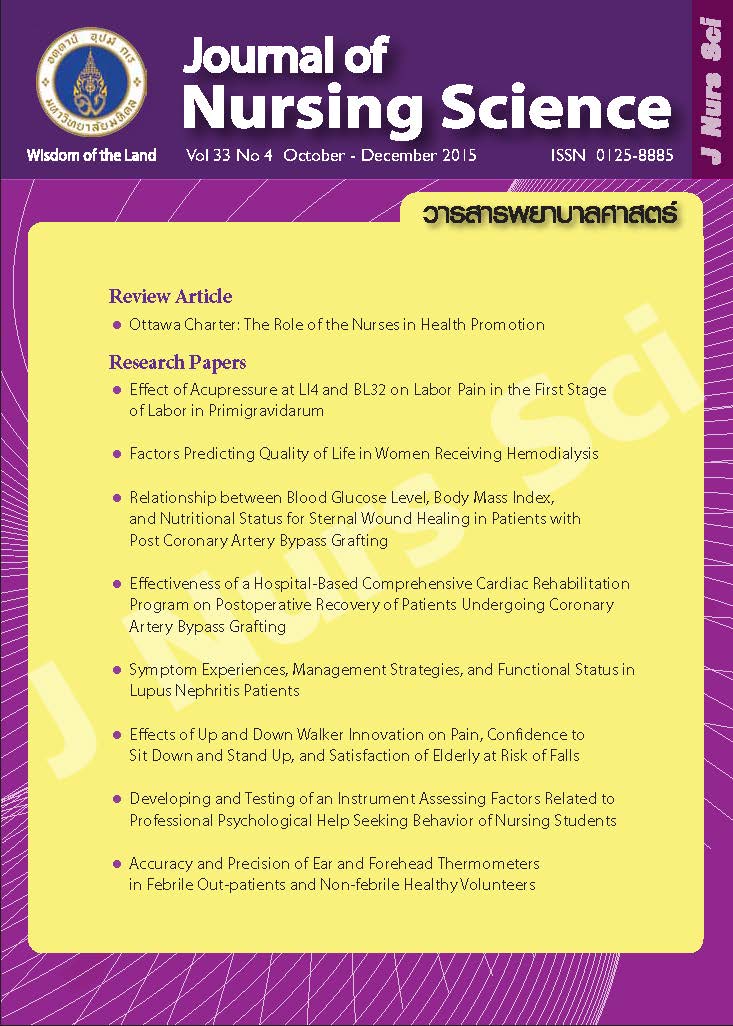Factors Predicting Quality of Life in Women Receiving Hemodialysis
Main Article Content
Abstract
Purpose: To study the predictive power of variables including sexual function, depression, marital relationship, and duration of dialysis on quality of life in women receiving hemodialysis.
Design: A correlational predictive study.
Method: The study participants consisted of 100 women over 18 years who received hemodialysis for at least three months. Data were collected by using demographic questionnaire, Female Sexual Function Index (FSFI), Center for Epidemiologic Study-Depression Scale (CES-D), Dyadic Adjustment Scale (DAS), and Thai version of WHO’s Quality of Life Brief questionnaire (WHOQOL–BREF–THAI). Data were analyzed using descriptive statistics and multiple regression.
Main findings: The overall quality of life of women receiving hemodialysis was at a moderate level (M = 88.26, SD = 13.81). 84% of the sample had sexual dysfunction and 46% had depression. According to the results of the multiple regression analysis, all
independent variables jointly explained 39% of the sample variances in quality of life (R2 = .390, F4,95 = 15.159, p < .05). The only one factor predicting quality of life with statistical significance was depression (β = - .623, p < .05).
Conclusion and recommendations: According to the study findings, women receiving hemodialysis should be screened for depression and interventions should be designed to promote their quality of life. In doing so, they will be able to live better with their chronic illness and prolong treatment.
ปัจจัยทำนายคุณภาพชีวิตในผู้หญิงที่ได้รับการฟอกเลือดด้วยเครื่องไตเทียม
บทคัดย่อ
วัตถุประสงค์: เพื่อศึกษาอำนาจการทำนายของตัวแปร การทำหน้าที่ทางเพศ ภาวะซึมเศร้า ความสัมพันธ์ระหว่างคู่สมรส และระยะเวลาในการรับการรักษาด้วยการฟอกเลือดด้วยเครื่องไตเทียม ต่อคุณภาพชีวิตในผู้หญิงที่ได้รับการฟอกเลือดด้วยเครื่องไตเทียม
รูปแบบการวิจัย: การศึกษาความสัมพันธ์เชิงทำนาย
วิธีดำเนินการวิจัย : กลุ่มตัวอย่างเป็นผู้ป่วยหญิงอายุตั้งแต่ 18 ปีขึ้นไป ได้รับการฟอกเลือดด้วยเครื่องไตเทียมมาแล้วอย่างน้อยสามเดือน จำนวน 100 ราย เก็บรวบรวมข้อมูลโดยใช้แบบสอบถามข้อมูลส่วนบุคคลแบบสอบถามการทำหน้าที่ทางเพศ แบบสอบถามภาวะซึม เศร้า แบบสอบถามความสัมพันธ์ระหว่างคู่สมรสและแบบสอบถามคุณภาพชีวิต วิเคราะห์ข้อมูลโดยใช้สถิติเชิงบรรยาย และสถิติถดถอยพหุคูณ
ผลการวิจัย: กลุ่มตัวอย่างมีคะแนนเฉลี่ยคุณภาพชีวิตโดยรวมอยู่ในระดับปานกลาง (M = 88.26, SD = 13.81) ร้อยละ 84 มีปัญหาการทำหน้าที่ทางเพศ และร้อยละ 46 มีปัญหาซึมเศร้า ตัวแปรอิสระทุกตัวสามารถร่วมกันทำนายคุณภาพชีวิตได้ร้อยละ 39 (R2 = .390, F(4,95) = 15.159, p < .05) และปัจจัยที่สามารถทำนายคุณภาพชีวิตในผู้หญิงที่ได้รับการฟอกเลือดด้วยเครื่องไตเทียมอย่างมีนัยสำคัญทางสถิติ คือ ภาวะซึมเศร้า (β = - .623, p < .05)
สรุปและข้อเสนอแนะ: จากผลการศึกษาในครั้งนี้ผู้หญิงที่ได้รับการฟอกเลือดด้วยเครื่องไตเทียมควรได้รับการคัดกรองปัญหาภาวะซึมเศร้า เพื่อส่งเสริมคุณภาพชีวิตให้ดีขึ้น และสามารถปรับตัวอยู่กับภาวะโรคเรื้อรัง และการรักษาที่ยาวนานได้ต่อไป
คำสำคัญ: การฟอกเลือดด้วยเครื่องไตเทียม คุณภาพชีวิต การทำหน้าที่ทางเพศ ภาวะซึมเศร้า
Article Details
Copyright Notice: Nursing Science Journal of Thailand has exclusive rights to publish and distribute the manuscript and all contents therein. Without the journal’s permission, the dissemination of the manuscript in another journal or online, and the reproduction of the manuscript for non-educational purpose are prohibited.

Disclaimer: The opinion expressed and figures provided in this journal, NSJT, are the sole responsibility of the authors. The editorial board bears no responsibility in this regard.


